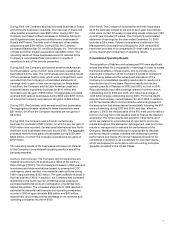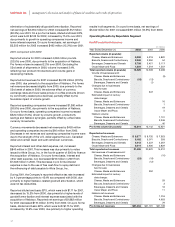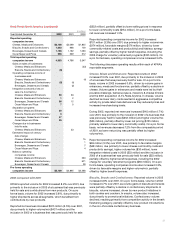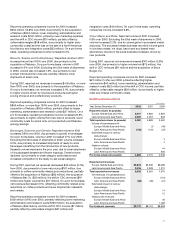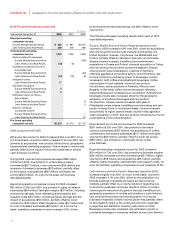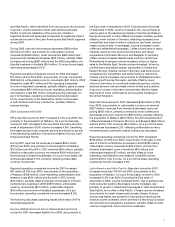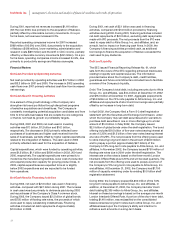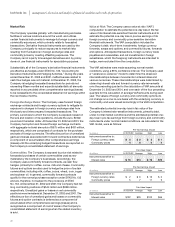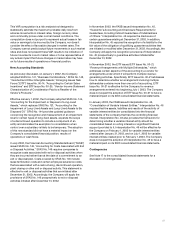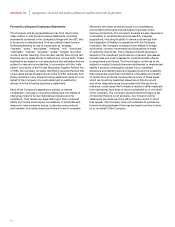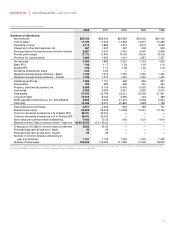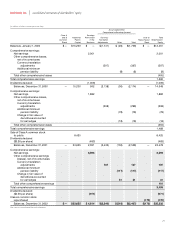Kraft 2002 Annual Report Download - page 43
Download and view the complete annual report
Please find page 43 of the 2002 Kraft annual report below. You can navigate through the pages in the report by either clicking on the pages listed below, or by using the keyword search tool below to find specific information within the annual report.
As discussed in Notes 3, 7 and 8 to the consolidated financial
statements, the Company’s total debt of $14.4 billion at December
31, 2002, which includes borrowings from Altria Group, Inc. and
affiliates, is due to be repaid as follows: in 2003, $4.3 billion; in
2004-2005, $1.6 billion; in 2006-2007, $2.6 billion; and thereafter,
$5.9 billion. Debt obligations due to be repaid in 2003 will be
satisfied with a combination of short-term borrowings, long-term
borrowings and operating cash flows. The Company’s debt-to-
equity ratio was 0.56 at December 31, 2002 and 0.68 at
December 31, 2001.
Credit Ratings: The Company’s credit ratings by Moody’s at
December 31, 2002 were “P-1” in the commercial paper market
and “A2” for long-term debt obligations. The Company’s credit
ratings by Standard & Poor’s at December 31, 2002 were “A-1”
in the commercial paper market and “A-” for long-term debt
obligations. The Company’s credit ratings by Fitch Rating
Services at December 31, 2002 were “F-1” in the commercial
paper market and “A” for long-term debt obligations. Changes
in the Company’s credit ratings, although none are currently
anticipated, could result in corresponding changes in the
Company’s borrowing costs. However, none of the Company’s
debt agreements require accelerated repayment in the event of
a decrease in credit ratings.
Credit Lines: The Company and its subsidiaries maintain
credit lines with a number of lending institutions, amounting to
$5.6 billion at December 31, 2002. Approximately $5.4 billion of
these lines were undrawn at December 31, 2002. Certain of these
credit lines were used to support commercial paper borrowings
of $1.4 billion at December 31, 2002, the proceeds of which were
used for general corporate purposes. Approximately $600 million
of these credit lines are available to meet the short-term working
capital needs of the Company’s international businesses. At
December 31, 2002, the Company’s credit lines also include a
$2.0 billion, five-year revolving credit facility expiring in July 2006
and a $3.0 billion 364-day revolving credit facility expiring in
July 2003. These credit facilities require the maintenance of a
minimum net worth, as defined in the credit facility, of $18.2
billion, which the Company met at December 31, 2002. The
Company does not currently anticipate any difficulty in continuing
to meet this covenant requirement. The foregoing revolving
credit facilities do not include any other financial tests, any
credit rating triggers or any provisions that could require the
posting of collateral. The five-year revolving credit facility
enables the Company to reclassify short-term debt on a long-
term basis. At December 31, 2002, $1.4 billion of commercial
paper borrowings that the Company intends to refinance were
reclassified as long-term debt. The Company expects to continue
to refinance long-term and short-term debt from time to time.
The nature and amount of the Company’s long-term and short-
term debt and the proportionate amount of each can be
expected to vary as a result of future business requirements,
market conditions and other factors.
Guarantees and Commitments: As discussed in Note 17 to the
consolidated financial statements, the Company had third-party
guarantees, which are primarily derived from acquisition and
divestiture activities, of $36 million at December 31, 2002.
Substantially all of these guarantees expire through 2012, with
$12 million expiring in 2003. The Company is required to perform
under these guarantees in the event that a third-party fails to
make contractual payments or achieve performance measures.
The Company has recorded a liability of $21 million at December
31, 2002 relating to these guarantees. In addition, at December 31,
2002, the Company was contingently liable for $58 million of
guarantees related to its own performance. These include surety
bonds related to dairy commodity purchases and guarantees
related to letters of credit. Guarantees do not have, and are not
expected to have, a significant impact on the Company’s liquidity.
The Company’s consolidated rent expense for 2002 was
$437 million. Accordingly, the Company does not consider its
lease commitments to be a significant determinant of the
Company’s liquidity.
The Company believes that its cash from operations, existing
credit facilities and access to global capital markets will provide
sufficient liquidity to meet its working capital needs, planned
capital expenditures and payment of its anticipated quarterly
dividends.
Equity and Dividends
Dividends paid in 2002 and 2001 were $936 million and
$225 million, respectively, reflecting the payment of four quarterly
dividends during 2002, compared with one during 2001, as well
as a higher dividend rate in 2002. During the third quarter of 2002,
the Company’s Board of Directors approved a 15.4% increase in
the quarterly dividend rate to $0.15 per share on its Class A and
Class B common stock. As a result, the present annualized
dividend rate is $0.60 per common share. The declaration of
dividends is subject to the discretion of the Company’s Board
of Directors and will depend on various factors, including the
Company’s net earnings, financial condition, cash requirements,
future prospects and other factors deemed relevant by the
Company’s Board of Directors.
On June 21, 2002, the Company’s Board of Directors approved
the repurchase from time to time of up to $500 million of the
Company’s Class A common stock solely to satisfy the
obligations of the Company to provide shares under its 2001
Performance Incentive Plan, 2001 Director Plan for non-employee
directors, and other plans where options to purchase the
Company’s Class A common stock are granted to employees
of the Company. During 2002, the Company repurchased
approximately 4.4 million shares of its Class A common stock at
a cost of $170 million.
Concurrently with the IPO, certain employees of Altria Group, Inc.
and its subsidiaries (other than the Company) received a one-time
grant of options to purchase shares of the Company’s Class A
common stock held by Altria Group, Inc. at the IPO price of
$31.00 per share. In order to completely satisfy this obligation and
maintain its current percentage ownership of the Company, Altria
Group, Inc. purchased 1.6 million shares of the Company’s Class
A common stock in open market transactions during 2002.
39


